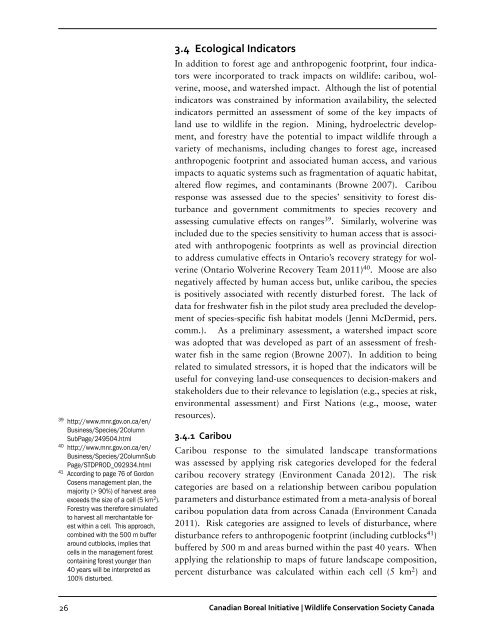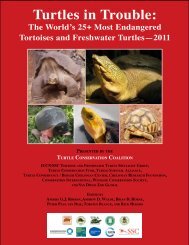Create successful ePaper yourself
Turn your PDF publications into a flip-book with our unique Google optimized e-Paper software.
39<br />
http://www.mnr.gov.on.ca/en/<br />
Business/Species/2Column<br />
SubPage/249504.html<br />
40<br />
http://www.mnr.gov.on.ca/en/<br />
Business/Species/2ColumnSub<br />
Page/STDPROD_092934.html<br />
41<br />
According to page 76 of Gordon<br />
Cosens management plan, the<br />
majority (> 90%) of harvest area<br />
exceeds the size of a cell (5 km 2 ).<br />
Forestry was therefore simulated<br />
to harvest all merchantable forest<br />
within a cell. This approach,<br />
combined with the 500 m buffer<br />
around cutblocks, implies that<br />
cells in the management forest<br />
containing forest younger than<br />
40 years will be interpreted as<br />
100% disturbed.<br />
3.4 Ecological Indicators<br />
In addition to forest age and anthropogenic footprint, four indicators<br />
were incorporated to track impacts on wildlife: caribou, wolverine,<br />
moose, and watershed impact. Although the list of potential<br />
indicators was constrained by information availability, the selected<br />
indicators permitted an assessment of some of the key impacts of<br />
land use to wildlife in the region. Mining, hydroelectric development,<br />
and forestry have the potential to impact wildlife through a<br />
variety of mechanisms, including changes to forest age, increased<br />
anthropogenic footprint and associated human access, and various<br />
impacts to aquatic systems such as fragmentation of aquatic habitat,<br />
altered flow regimes, and contaminants (Browne 2007). Caribou<br />
response was assessed due to the species’ sensitivity to forest disturbance<br />
and government commitments to species recovery and<br />
assessing cumulative effects on ranges 39 . Similarly, wolverine was<br />
included due to the species sensitivity to human access that is associated<br />
with anthropogenic footprints as well as provincial direction<br />
to address cumulative effects in Ontario’s recovery strategy for wolverine<br />
(Ontario Wolverine Recovery Team 2011) 40 . Moose are also<br />
negatively affected by human access but, unlike caribou, the species<br />
is positively associated with recently disturbed forest. The lack of<br />
data for freshwater fish in the pilot study area precluded the development<br />
of species-specific fish habitat models (Jenni McDermid, pers.<br />
comm.). As a preliminary assessment, a watershed impact score<br />
was adopted that was developed as part of an assessment of freshwater<br />
fish in the same region (Browne 2007). In addition to being<br />
related to simulated stressors, it is hoped that the indicators will be<br />
useful for conveying land-use consequences to decision-makers and<br />
stakeholders due to their relevance to legislation (e.g., species at risk,<br />
environmental assessment) and First Nations (e.g., moose, water<br />
resources).<br />
3.4.1 Caribou<br />
Caribou response to the simulated landscape transformations<br />
was assessed by applying risk categories developed for the federal<br />
caribou recovery strategy (Environment <strong>Canada</strong> 2012). The risk<br />
categories are based on a relationship between caribou population<br />
parameters and disturbance estimated from a meta-analysis of boreal<br />
caribou population data from across <strong>Canada</strong> (Environment <strong>Canada</strong><br />
2011). Risk categories are assigned to levels of disturbance, where<br />
disturbance refers to anthropogenic footprint (including cutblocks 41 )<br />
buffered by 500 m and areas burned within the past 40 years. When<br />
applying the relationship to maps of future landscape composition,<br />
percent disturbance was calculated within each cell (5 km 2 ) and<br />
26 Canadian Boreal Initiative | Wildlife Conservation Society <strong>Canada</strong>







![RaLand / SeaScape [PDF] - Wildlife Conservation Society](https://img.yumpu.com/49974326/1/190x245/raland-seascape-pdf-wildlife-conservation-society.jpg?quality=85)









